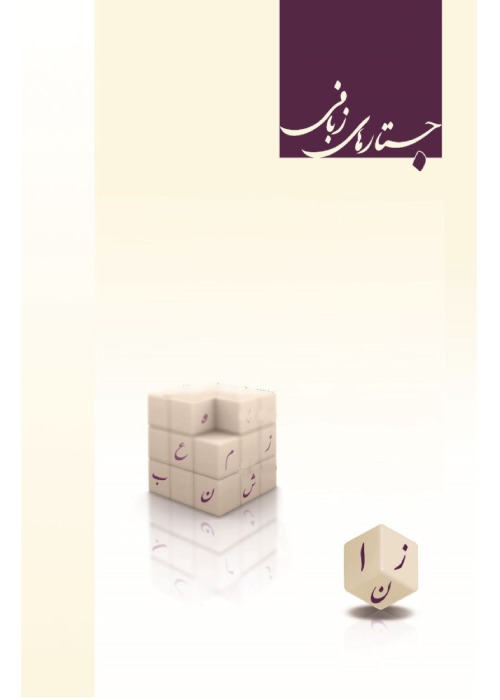Semantic and Syntactic Role of the Rā Morpheme in Sorani Kurdish
Author(s):
Abstract:
The purpose of this paper is to examine the role of semantic and syntactic rā morpheme in Sorani Kudish based on Van Valin’s (1996, 1997, 2007) Role and Reference Grammar. In this paper, it is shown that attaching –rā to the verb causes to absent all specific roles related to actor, e.g. agent, force, instrument and other specific roles such as experiencer, performer, consumer, etc. in the syntax level. These specific roles directly affect the undergoer. Since in all of the mentioned cases, the manifestation of -rā causes to the absence of actor in the syntax level, the crucial role of this morpheme is an anti-actor. In terms of semantic properties of NP, the more agency of NP, the more attaching –rā to the verb. Although the manifestation of -rā often occurs in the sentences containing two-argument verbs. It also occurs in intransitive sentences containing actor, and causes to the absence of the actor. Moreover, based on the presence of –rā morpheme in a structure, it further plays the role of a non-active morpheme, and it is shown that all non-active structures have semantically actor.Keywords: Role and Reference Grammar, Generalized semantic role, Actor, Undergoer, Anti-actor.The Study of Structural Differences in Numeral Phrases in Nominative and Objective Forms between Russian and Persian LanguagesAmir Hosseini1*, Shler Ebrahim-Sharifi21. Associate Professor, Department of Russian Language, University of Tehran, Tehran, Iran2. Ph.D. Student, Department of Russian Language, University of Tehran, Tehran, IranReceive: 22/8/2013 Accept: 24/12/2013One of the important aspects in learning foreign languages is considering differences between languages and their effects on the learning process. Number of objects is one general phenomenon, which is shown in different ways in different languages. There are many different ways to represent the number of objects in Russian and Persian languages, especially in morph-syntactic level. So learning and using numeral phrases (number + noun, number + adjective + noun) correctly in the nominative and objective cases in Russian is one of the difficult problems for Iranian students. In Russian language, this structure changes according to such criteria as grammatical case, number, animacy and inanimacy, and all of these structures are in contrast with similar structures in Persian. The purpose of this paper is to compare these structures between Russian and Persian languages. We further study and analysis the mistakes of Iranian students in learning and using numeral phrases in nominative and objective forms, and resolve them.Keywords: Number, Noun, Noun phrase, Syntax direction, Number.Discursive Analysis of Nima’s Poem Based on Semiotics Pattern (Case Study: Poetry, "Manzoome Be Shahriar") Akram Ayati *Assistant Professor, Department of French Language and Literature, Isfahan University, Isfahan, IranReceive: 15/9/2013 Accept: 11/1/2014The “Discursive Semiotics” of speech is proposed as a new method for the analysis of literary texts in which the production of meaning is directly linked with sensory conditions’ perceptive. In these circumstances, the meaning does not follow a logical plan, rather due to the presence of the perceptual subject that makes the sign phenomenal in discours, it is continuous, fluid, multi-dimensional and always being reborn. This study examines the discursive process in three dimensions (emotional, perceptual and aesthetic) in the poetry of Nima, and presents this approach as a new method of text analysis. The study also looks at the way in which the poet describes the world. This study not only creates a new reading of the poetry of Nima but also shows how the process of producing the dynamic sense in the poem is formed.Keywords: Discursive semiotics, “Manzoome Be Shahriar” of Nima, Perceptive dimension, Emotional and esthetic dimensions.The Dominant Psycholinguistic Approaches on the Process of Idiom Comprehension Omid Azad1*, Mojtaba Monshizadeh2 1. Ph.D. of Linguistics, Allameh Tabatabai University, Tehran, Iran2. Associate Professor of Linguistics, Allameh Tabatabai University, Tehran, IranReceive: 12/4/2014 Accept: 11/6/2014Idiomatic expressions are defined as linguistic structures, which, in contrast with ordinary sentences, can not be interpreted via meaning amalgamation of their constituents. This study aims at surveying the most important psycholinguistic models proposed in the study of idiom comprehension. Furthermore, the significant characteristics of these approaches have been discussed. The common feature of the traditional approaches is their emphasis on the literal meaning processing, that is, these approaches are either adherents of serial meaning processing, i.e., they would assert that literal meaning processing takes place before figurative meaning processing, or they are interested on the parallel meaning processing. However, the common ground of the novel approaches is that they emphasize on the important role of the contextual features in accelerating idiom comprehension. At the end, the notable graded salience hypothesis has been criticized, and the possibility of posing a unified theoretical framework in idiom comprehension has been investigated.
Keywords:
Language:
Persian
Published:
Language Related Research, Volume:6 Issue: 1, 2015
Page:
57
magiran.com/p1378066
دانلود و مطالعه متن این مقاله با یکی از روشهای زیر امکان پذیر است:
اشتراک شخصی
با عضویت و پرداخت آنلاین حق اشتراک یکساله به مبلغ 1,390,000ريال میتوانید 70 عنوان مطلب دانلود کنید!
اشتراک سازمانی
به کتابخانه دانشگاه یا محل کار خود پیشنهاد کنید تا اشتراک سازمانی این پایگاه را برای دسترسی نامحدود همه کاربران به متن مطالب تهیه نمایند!
توجه!
- حق عضویت دریافتی صرف حمایت از نشریات عضو و نگهداری، تکمیل و توسعه مگیران میشود.
- پرداخت حق اشتراک و دانلود مقالات اجازه بازنشر آن در سایر رسانههای چاپی و دیجیتال را به کاربر نمیدهد.
In order to view content subscription is required
Personal subscription
Subscribe magiran.com for 70 € euros via PayPal and download 70 articles during a year.
Organization subscription
Please contact us to subscribe your university or library for unlimited access!



